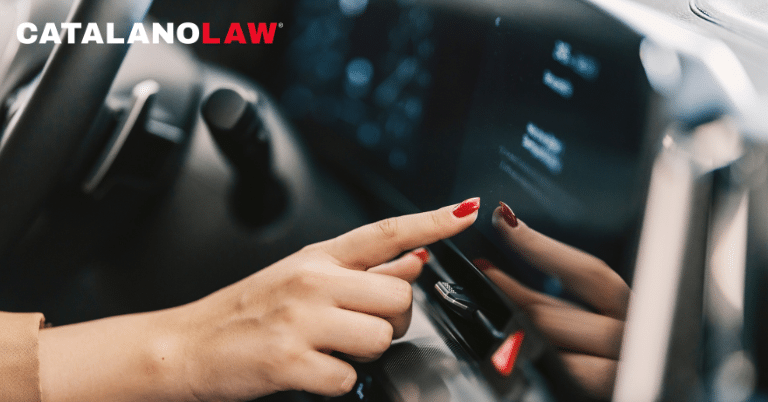
Request Free Consultation
To get answers to questions about your injury, contact Catalano Law for a FREE case evaluation. We’ll assess your case, explain your legal options, and recommend the next steps at no cost. We’re here when you need us.
Contact Form
General Contact Form

Vehicle safety is crucial for all road users, particularly in Onondaga County, New York, where motor vehicle injuries are the 4th leading cause of injury-related deaths and hospitalizations. Advanced technologies such as automatic braking, adaptive cruise control, and blind-spot monitoring improve road safety by reducing the likelihood of accidents.
However, while these innovations decrease the risk of collisions, they don’t entirely eliminate it. Understanding the functionality of these technologies and determining liability in accidents where they are involved is essential. This knowledge is key to protecting your rights and ensuring you receive fair compensation in the event of a collision.
New Auto Safety Tech
Automakers and the National Highway Safety Traffic Administration (NHTSA) have recently focused on implementing auto safety technologies in newer vehicles. For instance, in 2014, the NHTSA mandated that cars made after 2018 have backup cameras to reduce the number of backover accidents.
New safety innovations continue to emerge, including:
Adaptive Cruise Control (ACC)
Adaptive Cruise Control (ACC) is an advanced vehicle system that automatically controls the speed to maintain a set distance from the car ahead. It uses sensors and radar to detect vehicles in front and adjusts the speed by accelerating or braking as needed. This means drivers can enjoy a more comfortable drive without adjusting the cruise control or braking.
ACC helps prevent accidents by maintaining a safe following distance, reducing rear-end collisions. One report found that ACC systems typically maintain a greater following distance than most human drivers and help reduce the frequency of passing, minimizing the chances of an accident.
Lane Departure Warning Systems (LDWS)
Lane Departure Warning Systems use cameras and sensors to monitor a vehicle’s position within its lane. If the system detects the vehicle drifting out of its lane without turn signals, it alerts the driver through visual and audible warnings.
According to the Insurance Institute for Highway Safety (IIHS), LDWS-equipped vehicles have experienced an 18% reduction in crashes. Specifically, LDWS systems resulted in a 24% reduction in accidents that resulted in injury and an 86% reduction in fatal collisions.
Automatic Emergency Braking (AEB)
AEB systems engage the brakes automatically to lessen the severity of a collision when they sense an impending crash, and the driver fails to react in time. AEB uses sophisticated sensors and cameras to scan the road for possible obstacles or vehicles. If it anticipates a collision, the system intervenes by applying the brakes.
Research indicates the effectiveness of AEB, showing a 50% reduction in rear-end collisions and a 56% decrease in injuries from such accidents. This technology enhances road safety by acting as a co-pilot, ready to intervene to protect passengers and reduce accident severity.
Blind-Spot Monitoring
Blind-Spot Monitoring (BSM) is an advanced driver assistance system designed to alert drivers to hard-to-see vehicles in their blind spots. These systems detect vehicles in a driver’s blind spot during lane changes or when cars approach from the side.
Using sensors and cameras, BSM alerts drivers with visual, audible, or tactile warnings, helping avoid collisions. Research indicates that BSM reduces lane change accidents by up to 23%. This technology boosts road safety by helping drivers detect hard-to-see vehicles, like motorcycles, and reducing the risk of accidents during lane changes.
Legal Considerations
While these safety features can reduce the risk of crashes, irresponsible drivers can still cause serious accidents. If you are in a collision with another driver despite using ACC, AEB, or another technology, you can seek compensation with the help of a Syracuse car accident attorney from Catalano Law. This can include pursuing the following claims:
- PIP Insurance: In New York, personal injury protection insurance (PIP) will cover your medical bills and 80% of lost wages, no matter who caused the crash. We can help you file for these benefits under your PIP policy.
- At-Fault Driver’s Liability Insurance: If the other driver caused your injuries, for example, by speeding or failing to properly maintain their tires in winter, we can help you file a claim with their liability insurance to obtain a settlement for your missed earnings, medical expenses, and pain and suffering.
- Product Liability: Safety systems can malfunction, leading to serious injuries or fatalities. For instance, in 2018, a limo carrying 19 people in Upstate New York crashed due to a malfunction with the ABS, killing all passengers on board.
If a defective or malfunctioning system component causes your crash, we can help you seek compensation from the manufacturer or inspector who failed to address the issue.
Understand Your Legal Options if You’re Involved in a Crash
Emerging auto technologies reduce car accidents in New York and improve road safety. However, proper system upkeep and personal driver responsibility are still necessary to avoid collisions on the road.
If you are hurt in an accident in Central New York, our experienced attorneys at Catalano Law can help with your case. We’ll thoroughly examine the circumstances of your crash, collaborating with accident reconstructionists and system specialists to identify the cause of the collision and establish liability.
When you’ve been injured in an accident, there’s a lot on the line for both you and the insurance company. Contact us today for a free case review and get the legal representation you need to protect your rights and secure the settlement you deserve.

